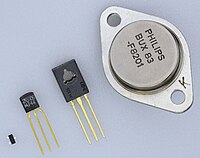
Photo from wikipedia
Photonic transistor memory has received increasing attention as next-generation optoelectronic devices for light fidelity (Li-Fi) application due to the attractive advantages of ultra-speed, high security, and low power consumption. However,… Click to show full abstract
Photonic transistor memory has received increasing attention as next-generation optoelectronic devices for light fidelity (Li-Fi) application due to the attractive advantages of ultra-speed, high security, and low power consumption. However, most transistor-type photonic memories developed to date still rely on electrical bias for operation, imposing certain limits on data transmission efficiency and energy consumption. In this study, the dual manipulation of "photo-writing" and "photo-erasing" of a novel photonic transistor memory is successfully realized by cleverly utilizing the complementary light absorption between the photoactive material, n-type BPE-PTCDI, in the active channel and the hybrid floating gate, CH3NH3PbBr3/poly(2-vinylpyridine). The fabricated device not only can be operated under the full spectrum but also shows stable switching cycles of photo-writing (PW)-reading (R)-photo-erasing (PE)-reading (R) (PW-R-PE-R) with a high memory ratio of ∼104, and the memory characteristics possess a stable long-term retention of >104 s. Notably, photo-erasing only requires 1 s light illumination. Due to the fully optical functionality, the rigid gate electrode is removed and a novel two-terminal flexible photonic memory is fabricated. The device not only exhibits stable electrical performance after 1000 bending cycles but also manifests a multilevel functional behavior, demonstrating a promising potential for the future development of photoactive electronic devices.
Journal Title: ACS applied materials & interfaces
Year Published: 2021
Link to full text (if available)
Share on Social Media: Sign Up to like & get
recommendations!